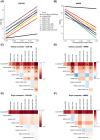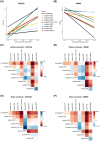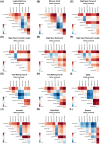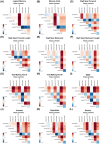Cognitive and neuropsychological trajectories in patients with mixed neurodegenerative pathologies
- PMID: 40761006
- PMCID: PMC12322323
- DOI: 10.1002/alz.70575
Cognitive and neuropsychological trajectories in patients with mixed neurodegenerative pathologies
Abstract
Introduction: The presence and interaction of multiple comorbid neuropathologies are a major contributor to the worldwide dementia burden.
Methods: We analyzed 1183 subjects from the National Alzheimer's Coordinating Center dataset with various combinations of isolated and mixed neurodegenerative pathologies and conducted mixed-effects multiple linear regression modeling to comprehensively compare the neurocognitive and neuropsychological trajectories between groups over time.
Results: In combination with Alzheimer's disease neuropathologic change, various combinations of limbic-predominant age-related transactive response DNA-binding protein 43 encephalopathy, Lewy body dementia, and cerebrovascular disease further impair global cognition and specific neurocognitive domains; however, they do not appear to extensively affect the rate of decline with time across these domains, suggesting an additive but not synergistic effect.
Discussion: These findings corroborate the known cumulative effects of mixed pathologies on cognition and add nuance to our understanding of their specific interactions, which is crucial for the development of biomarkers and effective therapeutics.
Highlights: Mixed neurodegenerative pathologies are common in the elderly population. The most common neurodegenerative pathologies were Alzheimer's disease neuropathologic change (ADNC), cerebrovascular disease (CVD), Lewy body dementia (LBD), and limbic-predominant age-related transactive response DNA-binding protein 43 encephalopathy (LATE). The addition of various combinations of comorbid CVD, LBD, and LATE to ADNC worsened overall performance on cognitive and neuropsychological testing across time. In general, the addition of multiple comorbid neurodegenerative pathologies did not influence the rate of decline across the evaluated time period.
Keywords: Alzheimer's disease neuropathologic change (ADNC); Clinical Dementia Rating (CDR); Lewy body dementia; Mini‐Mental State Examination (MMSE); National Alzheimer's Coordinating Center (NACC); Pick's disease; cerebrovascular disease; frontotemporal lobar dementia (FTLD); limbic‐predominant age‐related TDP‐43 encephalopathy (LATE); primary age‐related tauopathy (PART); progressive supranuclear palsy (PSP).
© 2025 The Author(s). Alzheimer's & Dementia published by Wiley Periodicals LLC on behalf of Alzheimer's Association.
Conflict of interest statement
T.G.O. has been a consultant for Sonae and Guidepoint, has received fees as a speaker from Eisai and conference fees covered from Roche and Lilly. T.E.R. is a consultant for Servier Pharmaceuticals. The remaining authors have no disclosures to report. The results presented in this paper have not been published previously in whole or in part.
Figures






References
MeSH terms
Grants and funding
- P30 AG066506/AG/NIA NIH HHS/United States
- P30 AG066444/AG/NIA NIH HHS/United States
- P30 AG066514/AG/NIA NIH HHS/United States
- P30 AG062421/AG/NIA NIH HHS/United States
- P30 AG066512/AG/NIA NIH HHS/United States
- P30 AG062429/AG/NIA NIH HHS/United States
- R21 AG078505/AG/NIA NIH HHS/United States
- P30 AG072978/AG/NIA NIH HHS/United States
- P30 AG062422/AG/NIA NIH HHS/United States
- P30 AG066509/AG/NIA NIH HHS/United States
- P30 AG066511/AG/NIA NIH HHS/United States
- P30 AG066462/AG/NIA NIH HHS/United States
- P30 AG066507/AG/NIA NIH HHS/United States
- P30 AG066515/AG/NIA NIH HHS/United States
- P20 AG068053/AG/NIA NIH HHS/United States
- P30 AG072958/AG/NIA NIH HHS/United States
- P30 AG066518/AG/NIA NIH HHS/United States
- P30 AG066530/AG/NIA NIH HHS/United States
- P30 AG072977/AG/NIA NIH HHS/United States
- P30 AG072947/AG/NIA NIH HHS/United States
- P30 AG072931/AG/NIA NIH HHS/United States
- P30 AG072979/AG/NIA NIH HHS/United States
- P30 AG062715/AG/NIA NIH HHS/United States
- P20 AG068077/AG/NIA NIH HHS/United States
- P30 AG072946/AG/NIA NIH HHS/United States
- 957607/Texas Alzheimer's Research and Care Consortium (TARCC)
- P30 AG066468/AG/NIA NIH HHS/United States
- P30 AG066508/AG/NIA NIH HHS/United States
- P30 AG066519/AG/NIA NIH HHS/United States
- P30 AG072959/AG/NIA NIH HHS/United States
- P30 AG072975/AG/NIA NIH HHS/United States
- P20 AG068024/AG/NIA NIH HHS/United States
- P30 AG066546/AG/NIA NIH HHS/United States
- 957581/Texas Alzheimer's Research and Care Consortium (TARCC)
- P30 AG072973/AG/NIA NIH HHS/United States
- P30 AG072976/AG/NIA NIH HHS/United States
- P30 AG072972/AG/NIA NIH HHS/United States
- P20 AG068082/AG/NIA NIH HHS/United States
LinkOut - more resources
Full Text Sources
Medical
Miscellaneous

